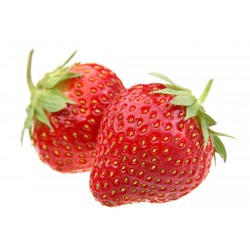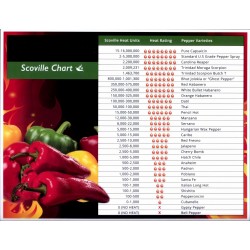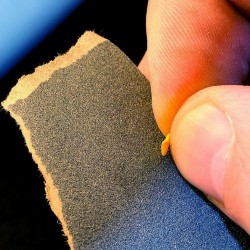Seeds Gallery Com,
5/
5
<p>La<span> </span><b>escala Scoville</b><span> </span>es una medida del<span> </span>picor o pungencia<span> </span>en los<span> </span>pimientos<span> </span>(también conocidos como<span> </span>guindillas,<span> </span>chiles<span> </span>o<span> </span>ajíes). Estos frutos de plantas del género<span> </span><i>Capsicum</i>contienen<span> </span>capsaicina, componente químico que estimula el receptor térmico en la<span> </span>piel, especialmente las membranas<span> </span>mucosas. El número de unidades Scoville (<b>SHU</b>, del inglés<span> </span><i>Scoville Heat Units</i>) indica la cantidad presente de capsaicina. Muchas<span> </span>salsas picantes<span> </span>usan la escala Scoville para publicitarse en los centros comerciales.</p>
<h2><span class="mw-headline" id="Procedimiento">Procedimiento</span></h2>
<div class="thumb tright">
<div class="thumbinner"><img alt="" src="https://upload.wikimedia.org/wikipedia/commons/thumb/7/76/Habanero.jpg/250px-Habanero.jpg" width="250" height="167" class="thumbimage" /><div class="thumbcaption">
<div class="magnify"></div>
El<span> </span>chile habanero, uno de los pimientos más picantes, perteneciente al género<span> </span><i>Capsicum</i>. Muchos habaneros oscilan entre las 200.000–300.000 SHU. La variedad<span> </span>Red Savinas<span> </span>puede llegar a las 580.000 SHU.</div>
</div>
</div>
<p>Esta escala fue nombrada por<span> </span>Wilbur Scoville, quien desarrolló el<span> </span><b>Examen Organoléptico Scoville</b><span> </span>en<span> </span>1912. Éste consiste en una solución con extracto del chile, que es diluida en<span> </span>agua<span> </span>azucarada<span> </span>hasta que el picante ya no puede ser detectado por un comité de examinadores, habitualmente cinco; el grado de disolución del extracto da su medida en la escala. Así, un<span> </span>chile dulce, que no contiene capsaicina, tiene cero en la escala de Scoville. Sin embargo, entre los chiles más picantes, como el<span> </span>chile habanero, se observa un grado de 300.000 o más. Esto indica que el extracto fue diluido 300.000 veces antes de que la capsaicina fuese indetectable. La gran debilidad de este método recae en su imprecisión, pues la prueba está sujeta a la subjetividad humana.</p>
<p>Hoy en día ya no se utiliza la<span> </span>medida organoléptica, sino métodos de<span> </span>análisis cuantitativo. Uno de los más habituales es la<span> </span>cromatografía. No obstante, se ha mantenido el nombre de la unidad de medida en honor de Scoville.</p>
<h2><span class="mw-headline" id="Escala">Escala</span></h2>
<p>El grado de picor de cualquier pimiento, tal y como se muestran en la escala en "unidades Scoville", es impreciso, debido a que las propias especies tienen variaciones —que pueden cambiar en un factor de 10 o incluso más— en función del cultivo, del clima o incluso del terreno de cultivo (esto es especialmente cierto en el caso de los<span> </span>habaneros).<sup id="cite_ref-1" class="reference separada">1</sup> Las imprecisiones descritas en los métodos de medida contribuyen a la inexactitud de los valores. Cuando se interpreta un cociente de la escala se debe tener esto en mente.<sup id="cite_ref-2" class="reference separada">2</sup></p>
<table class="wikitable" style="height:525px;"><caption>Tabla de Scoville</caption>
<tbody><tr style="height:36px;"><th style="height:36px;width:136px;">Unidades Scoville</th>
<th style="height:36px;width:613px;">Tipo de chile</th>
</tr><tr style="height:18px;"><td align="right" style="height:18px;width:136px;">16,000,000</td>
<td style="height:18px;width:613px;">Capsaicina</td>
</tr><tr style="height:36px;"><td align="right" style="height:36px;width:136px;">2,800,000-3,000,000</td>
<td style="height:36px;width:613px;">Pepper X<sup id="cite_ref-pepperx_3-0" class="reference separada">3</sup></td>
</tr><tr style="height:36px;"><td align="right" style="height:36px;width:136px;">1,900,500-2,480,000</td>
<td style="height:36px;width:613px;">Dragon's Breath</td>
</tr><tr style="height:36px;"><td align="right" style="height:36px;width:136px;">1,569,300-2,220,000</td>
<td style="height:36px;width:613px;">Carolina Reaper</td>
</tr><tr style="height:36px;"><td align="right" style="height:36px;width:136px;">1,300,000–2,000,000</td>
<td style="height:36px;width:613px;">Naga Viper,<span> </span>Trinidad Scorpion Butch T</td>
</tr><tr style="height:36px;"><td align="right" style="height:36px;width:136px;">855,000–1,041,427</td>
<td style="height:36px;width:613px;">Naga Jolokia,<span> </span>7 Pod Chaguanas<sup id="cite_ref-bosland_4-0" class="reference separada">4</sup><sup class="reference separada">5</sup></td>
</tr><tr style="height:21px;"><td align="right" style="height:21px;width:136px;">350,000–580,000</td>
<td style="height:21px;width:613px;">Habanero Savinas Roja<sup id="cite_ref-redsavina_6-0" class="reference separada">6</sup><sup id="cite_ref-redsavina2_7-0" class="reference separada">7</sup></td>
</tr><tr style="height:21px;"><td align="right" style="height:21px;width:136px;">100,000–350,000</td>
<td style="height:21px;width:613px;">Ají habanero,<sup id="cite_ref-homecookingabout_8-0" class="reference separada">8</sup><span> </span>Scotch Bonnet,<span> </span>Merkén,<sup id="cite_ref-homecookingabout_8-1" class="reference separada">8</sup><span> </span>Chile datil,<span> </span>Capsicum chinense</td>
</tr><tr style="height:21px;"><td align="right" style="height:21px;width:136px;">100,000–200,000</td>
<td style="height:21px;width:613px;">Rocoto<span> </span>o manzano,<sup id="cite_ref-scottr_9-0" class="reference separada">9</sup> chile jamaicano picante,<span> </span>piri piri</td>
</tr><tr style="height:18px;"><td align="right" style="height:18px;width:136px;">50,000–100,000</td>
<td style="height:18px;width:613px;">Chile thai,<span> </span>chile malagueta,<span> </span>chile chiltepín,<span> </span>chile piquín</td>
</tr><tr style="height:42px;"><td align="right" style="height:42px;width:136px;">30,000–50,000</td>
<td style="height:42px;width:613px;">Pimienta roja o de cayena,<span> </span>ají amarillo,<sup id="cite_ref-homecookingabout_8-2" class="reference separada">8</sup><span> </span>chile tabasco, calabrese, algunos tipos de<span> </span>chile chipotle<sup id="cite_ref-scottr_9-1" class="reference separada">9</sup></td>
</tr><tr style="height:18px;"><td align="right" style="height:18px;width:136px;">10,000–23,000</td>
<td style="height:18px;width:613px;">Chile serrano,<span> </span>chile de árbol, algunos tipos de<span> </span>chile chipotle</td>
</tr><tr style="height:18px;"><td align="right" style="height:18px;width:136px;">5,000-15,000</td>
<td style="height:18px;width:613px;">Chile Campana</td>
</tr><tr style="height:21px;"><td align="right" style="height:21px;width:136px;">5,000–8,000</td>
<td style="height:21px;width:613px;">Variedad de<span> </span>Nuevo Mexico<span> </span>del<span> </span>chile anaheim,<sup id="cite_ref-10" class="reference separada">10</sup> chile húngaro de cera<sup id="cite_ref-wax_11-0" class="reference separada">11</sup></td>
</tr><tr style="height:18px;"><td align="right" style="height:18px;width:136px;">2,500–5,000</td>
<td style="height:18px;width:613px;">Chile jalapeño,<span> </span>Pimiento de Padrón,</td>
</tr><tr style="height:18px;"><td align="right" style="height:18px;width:136px;">1,500–2,500</td>
<td style="height:18px;width:613px;">Chile rocotillo,<span> </span>Salsa Sriracha</td>
</tr><tr style="height:18px;"><td align="right" style="height:18px;width:136px;">1,000–1,500</td>
<td style="height:18px;width:613px;">Chile poblano</td>
</tr><tr style="height:21px;"><td align="right" style="height:21px;width:136px;">500–1,000</td>
<td style="height:21px;width:613px;">Chile anaheim<sup id="cite_ref-12" class="reference separada">12</sup></td>
</tr><tr style="height:18px;"><td align="right" style="height:18px;width:136px;">100–500</td>
<td style="height:18px;width:613px;">Pimiento,<span> </span>pepperoncini,<span> </span>pimienta banana</td>
</tr><tr style="height:18px;"><td align="right" style="height:18px;width:136px;">0</td>
<td style="height:18px;width:613px;">No picante,<span> </span>pimiento verde</td>
</tr></tbody></table>









